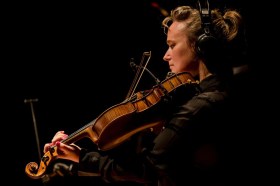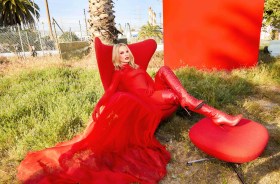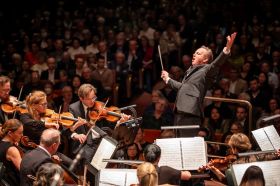Image: Madama Butterfly, Opera Australia
The high level of subsidy is consistent with other major performing arts companies. Major dance companies are subsidised at a rate of $63 a ticket and orchestras even higher at $86 a ticket. But, unlike most other art forms, the subsidy is not delivering audiences to opera.
The National Opera Review has found that despite increasing funding, Australia’s opera companies are facing reduced audiences, growing debt, and reduced artistic vibrancy.
Opera Queensland is in particularly desperate straits, relying on funding agencies for cash flow.
Opera Australia is in a stronger position, but largely through relying on capital reserves and sacrificing opera repertoire for musicals, which now account for 51% of the company’s performances and paid attendances, and 48% of its box office.
Reduced artistic vibrancy
Trying to keep above water financially appears to have reduced the artistic vibrancy of opera in Australia with fewer productions, a narrower repertoire, and less opportunity for artists.
‘Artistic vibrancy lies at the core of each major opera company creating a cycle of success.
‘However, companies under financial pressure, such as that being experienced by the Major Opera Companies, may initiate a short-term response that, while understandable, can longer-term create unintended consequences that erode and even undermine their artistic vitality. In those circumstances, the dynamics related to a cycle of success may be disrupted.’
Major opera companies have reduced the number of productions, resulting in fewer opportunities for artists. Companies are less able to undertake new productions, which the Review identifies as the ‘life blood of opera companies’ and are more likely to use international principals or depend on international co-productions.
‘The trend for the major opera companies to undertake new productions in association with international companies has potentially adverse implications for Australian creative and design teams and technical craftspeople and manufacturing staff.
‘This trend, when combined with a reduced number of productions, might erode Australia’s capacity to provide a career path for Australian directors, designers and creative staff.’
Declining opera audiences
Overall audiences for the major opera companies have increased by about 9% a year, but these audiences are going to musicals and special events, not to mainstage opera.
Audiences for opera itself have declined dramatically. Between 2007 and 2010, audiences for opera decreased by 36% and revenue declined by 15%. Theatre, classical music and dance/ballet also experienced significant negative trends during this period, hit by the GFC. But where the other sectors recovered, ballet continued to decline slightly and opera continued to fall steeply, dropping another 16% from 2010 to 2013.
This decrease occurred with both subscribers and single ticket sales and was worse for Opera Australia, particularly in Sydney.
Increasing funding
Major opera companies receive about 16% of all core Government funding for the major performing arts companies, which is roughly proportionate to the four companies out of the 26 majors which are opera companies. Of that 16%, almost three quarters, or 74.1% of that $24.1 million went to Opera Australia, with the rest shared by Opera Queensland, the State Opera of South Australia, and WA Opera.
From 2004 to 2014, Federal and State Government funding for the major opera companies has increased from $25.8 million to $36.8 million, an increase of 3.6% per annum.
But the amount of project funding opera receives is way out of proportion to its audiences. The Review found an increasing proportion of funding comes through project funding. Opera received a stunning three quarters of the project funding provided to major performing arts companies in 2014 ($3.4 million out of $4.3 million).
The Review also noted that, as a result of changes made by the Cultural Ministers Council in 2011, there was no system for determining how major arts companies are funded.
‘No underpinning logic currently exists as the basis on which the major opera companies (or any major performing arts company) are currently funded. As a result, funding variations are appearing,’ the Review reported in a Discussion Paper released on 25 September.
Rising costs
Opera companies are receiving more government funding but ticket revenue is falling and costs are increasing faster than income.
But costs for all the opera companies increased more sharply than funding. The average cost per staging of a mainstage production has risen by 10% and the revenue per staging has fallen by 8%. Mainstage productions, regional touring, education and community programs all lose money.
For every $1 it earns or receives Opera Australia spends $1.69, compared to $1.35 in 2009.
The exceptions are musicals, which now comprise half of OA’s programs – but the Review raises questions as to whether the government should be subsidising a company to produce musicals, which can be successfully mounted by commercial producers.
Companies in the red
The simple result of spending more than you earn, as Mr Micawber observed, is debt.
Opera Australia has incurred a cumulative deficit of $4.4 million in the past two years and has had to turn to its capital fund to manage.
Opera Queensland is significantly worse off, operating in deficit with no reserves. OperaQ has made a loss in each of the past six years, generating a cumulative deficit of $2.9 million. The Review described it as ‘under severe financial pressure’ and said the company needed support from funding agencies just to pay its bills..
‘Opera Queensland’s weak operating performance has led to a significant decline in its cash position, with its needing support from funding agencies to meet its cash flow requirements. This situation is exacerbated by its having negative reserves.’
The Review described State Opera SA as ‘financially vulnerable, despite acting prudently’ and WA Opera as ‘well managed, but experiencing challenges.’
Responding to the Review, Opera Queensland General Manager Russell Mitchell said OperaQ welcomed the forensic light it shined on the challenges facing major opera companies.
‘In particular, we appreciate the focus on the significant financial challenges Opera Queensland has faced in recent years.
‘Since 2012 Opera Queensland has been engaged in a strategic process to rebuild its financial, artistic and community capital. We believe we have ‘turned a corner’ in this process would like to use this opportunity to share the good news that the company expects to post a surplus in 2015 in excess of $200,000 – its best result in 10 years,’ he said.
Mitchell said initiatives such as $25 tickets were attracting new audiences. ‘More than three-quarters of the people who bought over 3,000 $25 tickets to La Traviata and Candide in 2015 had never been to an OperaQ performance before.’
Australia Council losing control
The Review found that changes to the funding environment meant funding agencies such, particularly the Australia Council, were less able to direct strategy and management at the opera companies.
‘In aggregate, these changes contributed to a significant shift in the balance of authority in favour of the companies, away from the funding agencies. Importantly, this gave the major opera companies far greater ability to determine their strategic direction, independently of Government agencies.
‘In combination with the stretching of staffing resources at the Australia Council and the change in status of the Major Performing Arts Panel within the Australia Council, the impact was a diminution of the role of the funding agencies in overseeing the major opera companies.’
This observation is particularly significant in the light of the National Program for Excellence in the Arts (NPEA) established in the 2015 Budget with funding taken from the Australia Council and currently the subject of a Senate Inquiry. By providing project funding outside the Australia Council from the Ministry, the NPEA promises to further remove major performing arts companies from the Australia Council assessment and review process.
To view the discussion paper and find out how to make a submission, visit: arts.gov.au/national-opera-review






